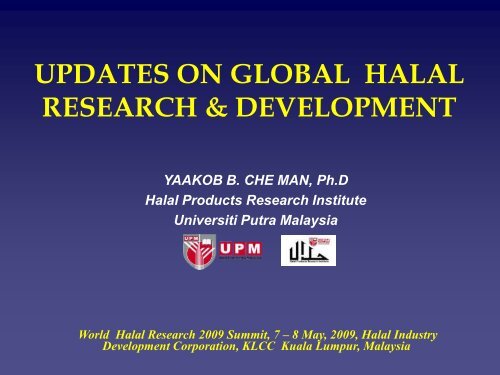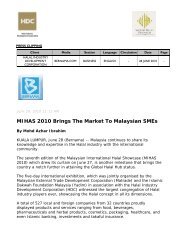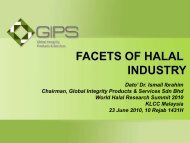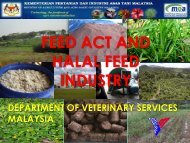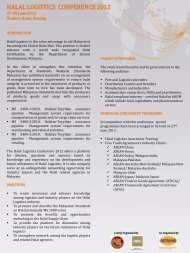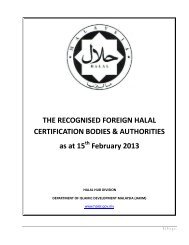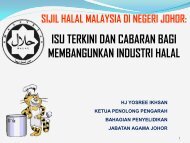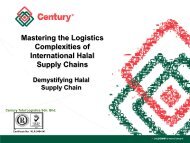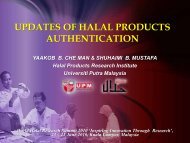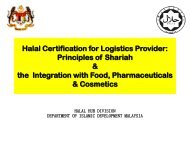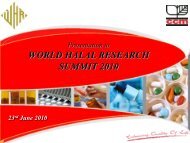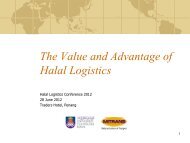UPM GEARED UP TOWARDS SERVICING A ... - World Halal Week
UPM GEARED UP TOWARDS SERVICING A ... - World Halal Week
UPM GEARED UP TOWARDS SERVICING A ... - World Halal Week
You also want an ePaper? Increase the reach of your titles
YUMPU automatically turns print PDFs into web optimized ePapers that Google loves.
<strong>UP</strong>DATES ON GLOBAL HALAL<br />
RESEARCH & DEVELOPMENT<br />
YAAKOB B. CHE MAN, Ph.D<br />
<strong>Halal</strong> Products Research Institute<br />
Universiti Putra Malaysia<br />
<strong>World</strong> <strong>Halal</strong> Research 2009 Summit, 7 – 8 May, 2009, <strong>Halal</strong> Industry<br />
Development Corporation, KLCC Kuala Lumpur, Malaysia
Scope<br />
• Introduction<br />
• <strong>Halal</strong> Products Perspectives<br />
• Issues In <strong>Halal</strong> Industry<br />
• <strong>Halal</strong> Certification<br />
• Challenges to <strong>Halal</strong> Authentication<br />
• Updates on R & D of Analytical Techniques for<br />
<strong>Halal</strong> Food Authentication<br />
• <strong>Halal</strong> Products Research Institute<br />
• Conclusions
Introduction<br />
• <strong>Halal</strong> is a Qur‟anic term meaning „permitted,<br />
allowed or lawful‟. <strong>Halal</strong> when used in relation to<br />
food and other consumer goods, means<br />
“permissible for consumption and used by<br />
Muslims‟<br />
• Haram is the opposite of halal.<br />
• Shubhah or Mashbooh, means doubtful or<br />
suspected<br />
• <strong>Halal</strong> and haram are serious matters in Islam
حالالً طيبا<br />
ً<br />
<strong>Halal</strong> – permissible based on shariah rulings<br />
(religious, faith and spiritual)<br />
Thoyyib – Good or Wholesome (quality, safety,<br />
hygeinic, clean, nutritious, quality, authentic -<br />
scientific))
<strong>Halal</strong> Products Perspectives<br />
<strong>Halal</strong> from 2 perspectives :<br />
• Islamic perspective – <strong>Halal</strong> is permissible activity<br />
that must be observed by every Muslim. The<br />
opposite is haram which is prohibited activity<br />
• Industry perspective – <strong>Halal</strong> concept provides<br />
good business oportunities for everyone,<br />
Muslims or non-Muslims alike
Islamic Perspective<br />
In the selection of food and drink, and other<br />
consumer products, Islam has laid down 3<br />
very important guidelines:<br />
• Whether the consumption of the products are halal<br />
(permitted) or haram (prohibited) by Allah S.W.T.<br />
• Whether or not the materials are good and safe to be<br />
consumed or used by mankind (thoyyib)<br />
• Whether the products are obtained through halal or<br />
haram means (e.g. source of finance)
Cont..<br />
• Al-Quran has numerous injunctions instructing<br />
Muslims to choose and consume food and<br />
drinks, <strong>Halal</strong> and Good (<strong>Halal</strong>an Thoyyiba) and<br />
forbid haram items<br />
• Many Hadiths support verses from Al-Quran in<br />
regards to halal and haram matters
Al-Quran Surah Al-Maaidah<br />
“O ye who believe! Forbid not the good things which Allah<br />
has made <strong>Halal</strong> for you, and transgress not. Lo Allah loves<br />
not transgressors. Eat of that which Allah has bestowed<br />
on you as food <strong>Halal</strong> and Good, and keep your duty to<br />
Allah in Whom ye are believers.”<br />
(Verse 87 –88)
Al Qur’an Surah Al-Baqarah<br />
“He has only forbidden you dead meat, and blood,<br />
and the flesh of swine and that on which any other<br />
name hath been invoked besides that of God. But<br />
if one is forced by necessity, without willful<br />
disobedience, nor transgressing due limits, then is<br />
he guiltless. For God is oft-forgiving most<br />
merciful.”<br />
(Verse 173)
Hadith Bukhari and Muslim<br />
“<strong>Halal</strong> is clear and Haram is clear; in between these<br />
two are certain things that are shubhah (suspected).<br />
Many people may not know whether those items are<br />
<strong>Halal</strong> or Haram. Whosoever leaves them, he is innocent<br />
towards his religion and his conscience. He is, therefore,<br />
safe. Anyone who gets involved in any of these<br />
suspected items, he may fall into the unlawful and the<br />
prohibition. This case is similar to the one who wishes to<br />
raise his animals next to a restricted area, he may step<br />
into it. Indeed for every landlord there is a restricted<br />
area. Indeed the restrictions of Allah are<br />
the unlawful (Haram).”
<strong>Halal</strong> Industry Perspectives<br />
• Lucrative industry and huge opportunities for halal<br />
business - domestic and international trade<br />
• Demand for halal food and other Islamic consumer<br />
goods is increasing
Global <strong>Halal</strong> Market<br />
Services<br />
(USD$ 1<br />
trillion)<br />
Food<br />
(USD$ 0.58<br />
trillion)<br />
Non-food<br />
(USD$ 1.52<br />
trillion)<br />
Source: IMP 3 - Ministry of International Trade and Industry, Malaysia
Cont…<br />
• Food industry globally are looking at the „halalan<br />
thoyyiban‟ concept as a new tool for marketing<br />
• Currently, ~1.8 – 2.0 billion Muslims<br />
• To tap this lucrative market, the industry must<br />
understand and appreciate the religious and scientific<br />
basis of halal requirement
Issues in <strong>Halal</strong> Industry<br />
• <strong>Halal</strong> concept is simple; however, the industry is<br />
becoming more complex and confusing<br />
• Due to breathtaking technological development today<br />
and the diversification of sources acquired globally for<br />
consumer products processing and production,<br />
numerous number of processed products are available<br />
in the market<br />
• It is very challenging and increasingly difficult for<br />
Muslims to ensure the halal status of products in the<br />
market<br />
• This trend has raised concerns among Muslim<br />
consumers regarding new processed food and<br />
consumer products
<strong>Halal</strong> Food Suppy Chain<br />
‘From Farm to Plate’ Concept<br />
Farm<br />
Raw material:<br />
*Animals<br />
*Plants<br />
Processing<br />
Handling<br />
e.g. slaughtering<br />
Ingredients &<br />
Additives<br />
Processing/Unit Operations<br />
*Preliminary operation<br />
*Conversion operation<br />
*Preservation operation<br />
*Product development<br />
Handling<br />
Packaging<br />
Storage<br />
Storage & Distribution<br />
Transportation<br />
Consumption
Food Adulteration<br />
• Adulteration is an issue of major concern in the food<br />
trade and industry globally<br />
• Adulteration involving the replacement of high cost<br />
ingredients with lower grade and cheaper substitutes is<br />
a common phenomena in many countries<br />
• Adulteration of food products can be very attractive and<br />
lucrative for food manufacturers or raw material<br />
suppliers, e.g. recent melamine adulteration issue in<br />
baby foods
Porcine-based Products Ingredients<br />
• Pork is commonly found in many food products<br />
• Lard could be effectively blended with other vegetable<br />
oils to produce shortening, margarines and other<br />
specialty food oils<br />
• In some countries, food manufacturers choose to blend<br />
vegetable fats with lard to reduce production cost<br />
• In other instances, adulteration with porcine products<br />
could be unintentional, e.g. use of emulsifiers such as<br />
E-471, mono- and diglyceride from lard
HALAL CERTIFICATION<br />
• Food is only halal if the entire food chain, from farm to<br />
plate, is processed, handled and stored in accordance<br />
to Shariah or <strong>Halal</strong> Standards and Guidelines<br />
E.g - Malaysia Standard MS1500:2004 <strong>Halal</strong> Food:<br />
Preparation, Handling, Packaging and Storage –<br />
General Guidelines (First Revision)<br />
Codex Alimentarious – Codex General Guidelines for<br />
Use of the Term <strong>Halal</strong> (CAC GL-24/1997) – Secretariat<br />
of the Joint FAO/WHO Food Standard Programme<br />
originally based on JAKIM‟s Guidelines
HALAL GUIDELINES
Cont…<br />
• <strong>Halal</strong> is not just end-product certification but involves<br />
approval and verification of all halal ingredients at every<br />
stage of the production – i.e. <strong>Halal</strong> „From Farm to Plate”<br />
concept<br />
• Verification and validation of every item for halal<br />
compliance by competent Islamic Authorities is<br />
extremely important<br />
• Hence, more stringent monitoring system including rapid<br />
ang reliable analysis is needed by <strong>Halal</strong> Authorities
HALAL CERTIFICATION PROCESS IN<br />
MALAYSIA<br />
Application/Document Approval/Fee<br />
Premise Inspection/Audit/Sample<br />
Report Writing<br />
Panel Committee<br />
Issuance of <strong>Halal</strong> Certificate<br />
Monitoring and Enforcement/Sample
Challenges to <strong>Halal</strong> Authentication<br />
■ More stringent monitoring system is needed by<br />
<strong>Halal</strong> Authorities.<br />
■ Analytical techniques become a major challenge<br />
for authentication of halal products<br />
■ Reliable state-of-the-art scientific methods are<br />
required for analysis of non-halal components<br />
(e.g porcine origin) in halal products
Cont…<br />
■ Analysis should be able to reliably identify origin<br />
of food components<br />
■ Sensitive and robust enough to be applied to<br />
complex food/products matrices<br />
■ Analysis based on certain identified biomarkers<br />
- oil/fat-based<br />
- protein-based<br />
- DNA-based<br />
- metabolites-based
Methods Food samples Issue Detection<br />
limit of<br />
adulterant<br />
IR<br />
Global Updates on <strong>Halal</strong> R & D for <strong>Halal</strong><br />
Authentication<br />
Cake<br />
formulation<br />
Chocolate and<br />
its products<br />
Lard adulteration in<br />
shortening<br />
References<br />
4% (w/w) level (Syahariza et al., 2005)<br />
Lard addition 3% (w/w) level (Che Man et al., 2005)<br />
Biscuits Lard adulteration 4% (w/w) level (Syahariza, 2006)<br />
Edible oil Lard characterization NR (Guillen and Cabo, 1997)<br />
Meat<br />
Lard mixed with other<br />
meat<br />
NR (Che Man et al., 2001)<br />
Meat Pork identification NR (Al-Jowder et al., 1997)<br />
Meat Lard mixture 1% (w/w) level (Jaswir et al., 2003)<br />
HPLC Meat products Detection of pork and<br />
lard<br />
1% in beef,<br />
3% in mutton<br />
(Saeed et al., 1989)<br />
Meat products Detection of lard 5% (Rashood et al., 1995)<br />
Meat<br />
Detection of meat<br />
adulteration<br />
10% meat (Wissiack et al., 2003)<br />
Edible oil Contamination of lard NR (Marikkar et al., 2005)
Methods<br />
Food<br />
samples<br />
Issue<br />
GC Ghee Detection of lard in cow and<br />
buffalo ghee<br />
DSC<br />
Edible oil<br />
Ghee,<br />
butter<br />
Edible oil<br />
Adulteration of lard in some<br />
vegetable oils<br />
Detection limit<br />
of adulterant<br />
10% (buffalo),<br />
5% (cow)<br />
References<br />
(Farag et al.,<br />
1982)<br />
2% (w/w) lard (Marrikar et al.,<br />
2005)<br />
Adulteration of goat body fat 10% (w/w) level (Lambelet, 1983)<br />
Adulteration of cow and buffalo<br />
ghee by pig<br />
Detection of lard and lard<br />
contaminated with tallow<br />
Detection of lard and<br />
randomized lard in RBD palm oil<br />
Adulteration of RBD palm oil<br />
with lipase catalyzed<br />
interesterified lard (ERLD)<br />
Detection of lard in selected<br />
food product deep fried in lard<br />
Monitoring lard, tallow and<br />
chicken fat adulteration in<br />
Canola oil<br />
5% (w/w) level (Lambelet et al.,<br />
1980)<br />
1% tallow in lard (Kowalski, 1989)<br />
1% (w/w)<br />
lard/randomised<br />
lard<br />
(Marrikar et al.,<br />
2001)<br />
1% (w/w) ERLD (Marrikar et al.,<br />
2002)<br />
10% (w/w) (Marrikar et al.,<br />
2003)<br />
2% (tallow) (Marrikar et al.,<br />
2002)
HALAL PRODUCTS RESEARCH<br />
INSTITUTE<br />
VISION<br />
Upholding the Sanctity of<br />
<strong>Halal</strong> Through Research<br />
and Services<br />
MISSION<br />
Total Commitment<br />
Towards <strong>Halal</strong><br />
Globalization<br />
and Enterprise
R & D on <strong>Halal</strong> Products<br />
<strong>Halal</strong> Food<br />
Non-Food<br />
<strong>Halal</strong> Business<br />
Raw<br />
Materials<br />
Processed<br />
Food<br />
Leather<br />
Products<br />
Cosmatics &<br />
Personal Care<br />
Finance &<br />
Banking<br />
Pharmaceutical<br />
Products<br />
Marketing<br />
and<br />
Management<br />
Insurance<br />
Investment<br />
LABORATORY<br />
Products Innovation<br />
and Process<br />
Analysis &<br />
Authentication<br />
Policy and<br />
Management
Current R & D on <strong>Halal</strong> Products<br />
Analysis in HPRI<br />
• Fourier Transform Infrared (FTIR) spectroscopy<br />
• Electronic Nose (E-nose) technology<br />
• Differential Scanning Calorimetry (DSC)<br />
• Molecular Biology techniques<br />
• Chromatography (e.g. GC, GC-ToF-MS, HPLC, GCMS)<br />
• Telemetry EEG & ECG
Fourier Transform Infrared Spectroscopy
FTIR Spectroscopy<br />
• Spectroscopy is the study of the interaction of<br />
EMR with matter<br />
• IR has been used to provide information on the<br />
molecular composition and structure of a diverse<br />
range of materials<br />
• Samples (e.g. oils and fats, gelatin, leather,<br />
cosmetics) were analyzed to identify the<br />
differences in FTIR spectra profiles, hence the<br />
sources of origin
Lard in mixture with animal fats<br />
FTIR spectra of lard and body fats of lamb, cow, and<br />
chicken looks very similar, unless the intensities in<br />
region assigned with a, b, and c these frequencies<br />
was used for first differentiation
Discriminant analysis of lard in mixture with body fats of<br />
lamb, cow, and chicken (Che Man, 2009)<br />
lard in<br />
mixture with<br />
LBF<br />
lard in<br />
mixture with<br />
Cow-BF<br />
lard in<br />
mixture with<br />
Ch-BF
Discriminant Analysis Plot for FTIR Analysis of Gelatin<br />
Cooman‟s plot for two classes of gelatin: porcine gelatin<br />
and bovine gelatin.
Electronic Nose
Electronic Nose (E-nose)<br />
Technology<br />
• An instrument, which comprises an array of electronic<br />
chemical sensors and appropriate pattern recognition<br />
system, capable of recognizing simple or complex<br />
odor or smell<br />
• This technique was applied to monitor the presence<br />
of haram or unsafe ingredients (e.g.lard, pork etc in<br />
food samples)
SAW detector response vs time. Pure RBD palm olein (pink)<br />
overlay with RBD palm olein adulterated with 5% lard (black)
VaporPrint TM<br />
CORN OIL PEANUT OIL PALM OLEIN<br />
COCONUT OIL<br />
SESAME OIL<br />
LARD
Rapid Detection of Haram Meat (pork)<br />
by Electronic Nose<br />
VaporPrint TM<br />
Pork<br />
Chicken<br />
Beef<br />
Mutton<br />
Typical chromatograms of four different types of<br />
meat. Pork showed more aromatic compound<br />
corresponding to the number of peaks.
Standard<br />
Sample at 80°c<br />
Sample at 80°c<br />
Sample at 80°c<br />
Chromatogram of melamine standard (stock solution, 1040ppm)= 2mL<br />
and waterfall of sample (rabbit candy-triplicate)
Differential Scanning Calorimetry
Differential Scanning<br />
Calorimetry<br />
• Thermoanalytical technique for monitoring<br />
changes in physical or chemical properties of<br />
material by detecting heat changes<br />
• Thermogram profile show the presence of lard<br />
in food sample<br />
• Relatively simple, accurate and minimum<br />
amount of sample needed
DSC Thermogram<br />
A(GLD)<br />
A(0%)<br />
B(CRLD)<br />
B(1%)<br />
C(BT)<br />
D(MT)<br />
E(CF)<br />
C(2%)<br />
D(3%)<br />
E(4%)<br />
DSC cooling thermogram of<br />
different animal fats<br />
DSC cooling thermogram of RBDPO<br />
adulterated with genuine lard<br />
(increasing proportion)<br />
Source: J.M.N. Marikkar et al. Food Chemistry, 76 (2002) 249–258
Molecular Biology Techniques
Molecular Biology Techniques<br />
(i) DNA-based technique<br />
• DNA technique is a favorite approach for species<br />
identification because DNA is relatively stable even<br />
after processing<br />
• We develop method for species identification from<br />
pork and lard samples using PCR-RFLP and Realtime-PCR<br />
analysis<br />
• The analysis yielded excellent results for qualitative<br />
and quantitative detection of pig derivatives in food
M A1 A2 A3 D1 D2 D3 K1 K2 P1 P2<br />
500 bp<br />
≈360 bp<br />
228 bp<br />
131 bp<br />
M-1Kb DNA ladder<br />
A1, A2 and A3- chicken sausages of different brands<br />
D1, D2 and D3- beef sausages of different brands<br />
K1 and K2- pork sausages of different brands<br />
P1 and P2- unknown products<br />
Restriction Enzyme Analysis of PCR Amplified<br />
Cytochrome b Gene (sausages)
Real-time PCR<br />
Specificity test on pork primer designed against other meat species (beef and chicken)<br />
• Specificity of the pork-specific primers set designed was tested.<br />
• Only pork sample showed amplification while chicken, beef and no template control<br />
(NTC) did not exhibit any amplification.<br />
• Combination of the primers designed and real-time PCR method optimized gave a<br />
Ct value of 21.58 for pork samples.<br />
• No amplification was detected in the other two samples.
Real-time PCR<br />
Sensitivity test of pork primer with 10-fold serial dilutions<br />
Detection - 0.001ng of pork DNA. This is an essential discovery in terms of<br />
<strong>Halal</strong> identification of food products.
(ii) Protein-based technique<br />
• ELISA is used to determine the level of antibodies<br />
in a sample and useful because they are specific<br />
and are relatively simple to perform.<br />
• We developed method for detection of pig<br />
derivatives qualitatively in the food samples using<br />
ELISA technique<br />
• The analysis yielded excellent results for detection<br />
of pig derivatives in samples
ELISA Results<br />
1 2 3 4 5<br />
A<br />
B<br />
C<br />
D<br />
E<br />
F<br />
G<br />
H<br />
A1- positive control;<br />
B1 and C1- negative controls;<br />
D1- mutton,<br />
E1- beef;<br />
F1- chicken meat,<br />
G1, H1, A2 and B2-pork;<br />
C2- mutton fat;<br />
D2- beef fat;<br />
E2- chicken fat;<br />
F2, G2, H2, A3- lard;<br />
B3, C3 and D3- chicken sausages<br />
with different brands;<br />
E3, F3 and G3- beef<br />
sausages with different<br />
brands;<br />
H3 and A4- pork<br />
sausages with different<br />
brands;<br />
B4 and C4- unknown<br />
sausages;<br />
D4, E4 and F4-<br />
unknown casings;<br />
G4, H4, A5 and B5-<br />
bread with different<br />
brands;<br />
C5 and D5- biscuits<br />
with different<br />
brands; E5-<br />
homemade biscuit<br />
with 1% lard;<br />
F5- homemade<br />
biscuit with 50%<br />
lard;<br />
G5- homemade<br />
biscuits with 100%<br />
lard.
GCGC-ToF-MS
Animal FAME - 2D (GC x GC)<br />
Pig<br />
Cow<br />
Sheep
Lard FAME – 2D plot (preliminary)<br />
Name Formula S/N SI R.T. (s)<br />
Octanoic acid, methyl ester C9H18O2 245.18 891 510 , 1.150<br />
Methyl tetradecanoate C15H30O2 18137 935 1190 , 2.340<br />
Pentadecanoic acid, methyl ester C16H32O2 560.75 918 1405 , 2.530<br />
7-Hexadecenoic acid, methyl ester, (Z)- C17H32O2 4541 948 1585 , 2.850<br />
Hexadecanoic acid, methyl ester C17H34O2 108984 927 1635 , 2.800<br />
Heptadecanoic acid, methyl ester C18H36O2 2649.9 906 1875 , 2.850<br />
cis, cis-9,12-Octadecadienoic acid, methyl ester C19H34O2 8365.6 938 2035 , 3.380<br />
9,12-Octadecadienoic acid, methyl ester C19H34O2 51970 954 2040 , 3.470<br />
Name Formula S/N SI R.T. (s)<br />
9,12,15-Octadecatrienoic acid, methyl ester, (Z,Z,Z)- C19H32O2 2897.5 912 2055 , 3.590<br />
9-Octadecenoic acid (Z)-, methyl ester C19H36O2 43672 935 2060 , 3.300<br />
Octadecanoic acid, methyl ester C19H38O2 54674 918 2120 , 3.060<br />
5,8,11,14-Eicosatetraenoic acid, ethyl ester, (all-Z)- C22H36O2 506.47 849 2430 , 4.050<br />
11,14,17-Eicosatrienoic acid, methyl ester C19H32O2 19.768 842 2480 , 3.890<br />
11,14-Eicosadienoic acid, methyl ester C21H38O2 1651.2 906 2525 , 3.770<br />
11-Eicosenoic acid, methyl ester C21H40O2 1177.8 851 2540 , 3.570<br />
8,11,14-Eicosatrienoic acid, (Z,Z,Z)- C20H34O2 303.32 734 2540 , 4.010<br />
Distinguished FA components<br />
Occurrence of FA isomers with<br />
higher carbon chain (C>19) in lard
Distinguishing industrial alcohol and alcoholic<br />
beverage using GCxGC-ToF-MS<br />
RW<br />
W<br />
W<br />
CW<br />
IA<br />
TIC chromatogram of the industrial alcohol and alcoholic beverage sample by HS-SPME-<br />
GCxGC-ToF-MS. (RW) Contour plot of red wine; (WW) Contour plot of white wine; (CW)<br />
Contour plot of cooking wine; and (IA) Contour plot of industrial alcohol.
Conclusions<br />
• <strong>Halal</strong> and haram issues are serious matters for Muslims<br />
but also provide good business opportunities for everyone<br />
• Properly processed and halal certified consumer products<br />
are pertinent to capture the lucrative global halal market<br />
• R & D and application of new methods for halal analysis<br />
and authentication is much needed to uphold the<br />
credibility of halal certification programs<br />
• It is hoped that scientific advances on R & D on products<br />
authenticity would contribute to the integrity of <strong>Halal</strong><br />
certificates and further supporting halal trade and industry<br />
globally
THANK YOU & WASSALAM


